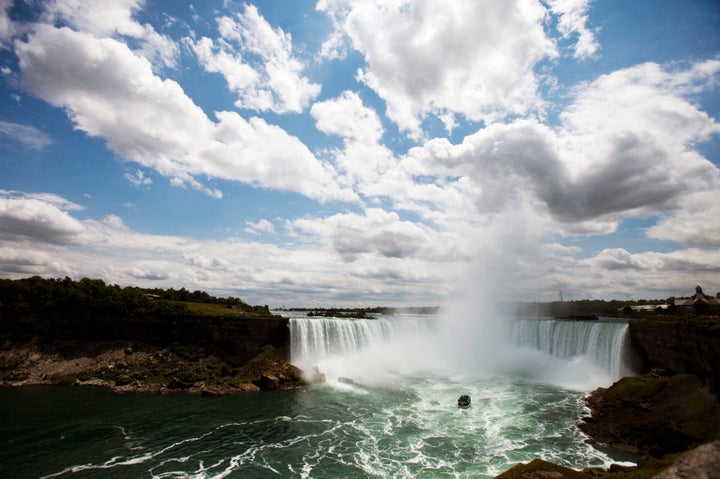
Everyone had been to Niagara Falls except for me -- I hate crowds and I don't like the idea of jockeying for position with camera-toting tourists. But, when I watched Nik Wallenda walk above the roiling Falls on TV last spring, I was reminded of the mystique and legends surrounding them and suddenly ached to see them in person. The Canadian side is less tacky than the American -- and winter is cheaper and less crowded -- so, on a spur-of-the-moment decision, I flew to Toronto, drove to Niagara-on-the-Lake, dumped my suitcase at a charming B&B in this historic, quaint town, and headed off to see the Falls. There was only one problem -- the Falls were obscured with fog. I peered over from the ledge, less than a football field away. I could hear the thrashing, thunderous roar, but could see only thick, white vapor. For all I knew, I could have been in Newark or Middle Earth.
Sure, I was disappointed, but I could try again the next day. Instead, I'd explore Niagara-on-the-Lake: I'd check out the historic sights, shop in the cute little boutiques on the main street and tour a few of the region's 135 wineries.
The Village of Niagara-on-the-Lake
Just a block away from my B&B (everything in the village is within walking distance) was a historical museum with relics from the Aboriginals and the war of 1812. I've never been a big history buff, but early the next morning I ran around the barracks and up to the ramparts of historic Fort George and then down to the Niagara River.
Another stop was the Laura Secord Homestead. This War of 1812 Canadian heroine overheard news of an impending American attack. On June 21, 1813, she ventured into the dead of night to walk 20 miles and warn the British forces. Her forewarning led to the British victory at the Battle of Beaver Dams, even though she wasn't recognized for her heroism until 1860 (when the future king, Albert Edward, prince of Wales, awarded her 100 pounds).
At the restored 200-year-old house, furnished with Laura Secord's original furniture, the guide pointed out a "settle bed" for unexpected guests (a wooden bench which converts into an uncomfortable bed with a straw mattress). "That's where 'settle down' comes from," she said. "Because you have to put the top down to go to sleep." In the kitchen was a bathtub; the family would bathe one at a time, starting with the husband, then the wife, from oldest to youngest child, and finally the baby. "By then," the guide said, "the water was so dark you couldn't see anything, which is where the expression 'Don't throw out the baby with the bathwater' comes from."
The Wineries of Niagara-on-the-Lake
A little-known fact is that Niagara is Canada's most celebrated grape- and wine-producing region, and their fine wines easily equal those of France, Chile and California. I toured the sparkling wine cellar of Trius Winery at Hillebrand Estates, where 250,000 bottles of sparkling wine were aging. I learned how to open a sparkling wine bottle (you don't want it to pop -- you twist the bottle until it slides off without a sound). Next stop: Ravine Winery in St. David for wine tasting and a delicious lunch in their floor-to-ceiling glass walls overlooking the lush countryside and vineyards. That evening, I had a tasting with wine pairings and a gourmet feast at the restaurant of the Charles Inn, a restored Georgian style manor house dating back to 1832. Naturally, I ended the evening with Niagara's famous ice wine before returning to my B&B, La Toscana di Carlotta at Burns House, a house which dates back to 1793 and was razed by retreating American troops in the War of 1812, rebuilt as an inn in 1818 and bought by a local merchant Joseph Burns. Florentine Carlotta Cattani and her husband, Kash, have owned the house for five years, and serve up hospitality as well as a four-course breakfast with fresh squeezed juice, fruit and yogurt, crostini (think pecorino and prosciutto), eggs with truffles and tiramisu.
Back to Niagara Falls
The next morning, it was raining and worse; it remained foggy and it seemed barely worth going back to the Falls. It looked as though I'd continue to be one of those who'd never seen Niagara Falls. I went into every boutique in the village of Niagara-on-the-Lake, visited the Mackenzie Printery & Newspaper Museum and looked at the antique medicines at the mid-Victorian Niagara Apothecary. It seemed to be clearing a little, but there was a complete whiteout. Discouraged, I headed to the Imax movie to learn about the native peoples who worshiped the thunder spirits and the first Europeans who came, and the adventurers such as the Great Blondin who tightrope walked over the river in 1860 and Annie Taylor, a 63-year-old schoolteacher, the first to go over the Falls in a barrel (and live to tell the tale).
I donned a plastic rain poncho at Journey Behind the Falls, and took an elevator down 150-feet through bedrock deep below the Falls. I walked through a tunnel until I arrived at a window where Horseshoe Falls tumbled past me from 13 stories above. The sound was deafening. I tried to get my head around the fact that one-fifth of the world's fresh water was crashing down to the basin below. A second tunnel led to an Observation Deck. I walked up the slippery stairs, expecting to see nothing, but the fog had lifted. From the railing's edge, I watched mesmerized as the thundering show of Falls exploded in endless fury. And there was nobody there except me.